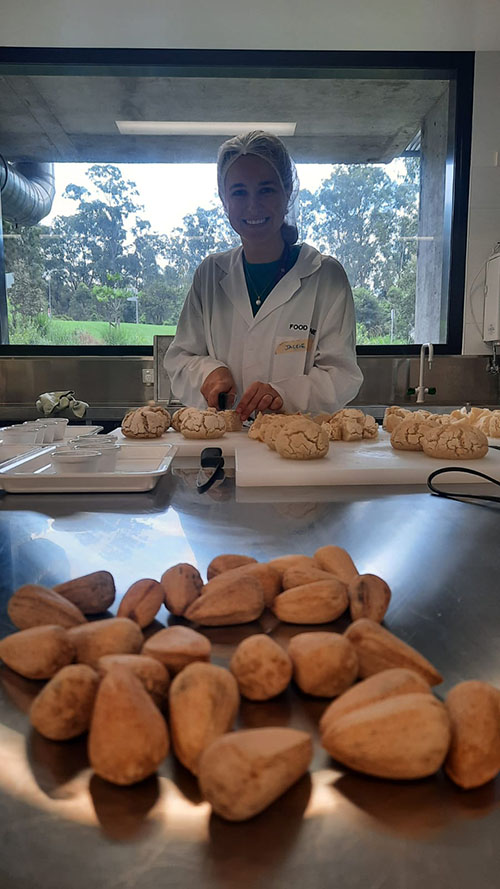A native Australian nut has the potential to be part of the burgeoning Indigenous bushfood industry, according to research led by The University of Queensland.
PhD candidate Jaqueline Moura Nadolny has studied the bunya nut (Araucaria bidwillii), a seed from a native conifer, and was the first to publish a paper on the nut’s composition and sensory properties.
It was a project that resonated with the Brazilian-born scientist, familiar with other nuts from the Araucaria family, eaten in South America.
“In Brazil you can see the nuts in the supermarkets – they make beer, they make flour, they make a lot of products,” Ms Moura Nadolny said.

“It wasn’t until after I started my project that I saw the bunya nut, and thought, oh wow, it’s the same, especially the inside and the taste.
“It was really interesting, because those nuts are from my region in the south, and I grew up eating them.”
Her research with UQ’s School of Chemical Engineering and QAAFI’s Centre for Nutrition and Food Sciences compared bunya nuts to the sweeter chestnut, and found they had a savoury taste and contained a lot of resistant starch like the potato, as well as protein, all the essential amino acids, minerals and fatty acids such as omega 3 and 6.
“Bunya nuts are not highly valued by many non-Indigenous folk because often when the cones drop, people don’t know it’s a food,” Ms Moura Nadolny said.
“But they are highly nutritious and very important to Indigenous communities in Queensland.
“Some communities had months-long gatherings, sometimes eating only bunya nuts often fermented in the ground”.
“It has great historical significance.”
Professor Odette Best, an Indigenous academic and researcher from the University of Southern Queensland helped Ms Moura Nadolny collect her bunya nuts specimens, taking her to trees she knows well.
“The bunya nut holds great cultural significance for First Nations peoples,” Professor Best said.
“Not only is it used as a deeply nourishing food source, it is also steeped in cultural practice and songlines for the Nations who survived and thrived with its usage.”

Ms Moura Nadolny said she hoped her research would increase awareness about the market potential of bunya nuts.
“It’s really promising,” she said.
“You can make gluten-free flour, as well as many other products.
“I hope the research can be the foundation for Indigenous communities to develop products and create businesses and jobs with those products.”
As well as the First Peoples links, Ms Moura Nadolny was inspired by research from her homeland in her own work.
“In Brazil, they have a lot of knowledge and technology for these nuts that I could bring here and share with Indigenous communities.
“I also hope things I discover here and learn from Indigenous communities can be taken back to Brazil.”
The UQ student was thrilled to be offered the cover when her paper was published and said she hoped to continue her research.
“I would like to keep working with food as I love it, particularly foods that are naturally found.
“I’m also interested in how these foods can be processed into highly nutritious commercial products.”
The paper was published in the Journal of Food Science DOI: 10.1111/1750-3841.16185), and was featured on the cover.
Ms Moura Nadolny worked with supervisors Professor Jason Stokes and Associate Professor Heather Smyth, with her PhD funded by the Australian Research Council’s training centre for Uniquely Australian Foods.
Media: Jaqueline Moura Nadolny, j.mouranadolny@uq.net.au; QAAFI Communications, Natalie MacGregor, n.macgregor@uq.edu.au, +61 (0)409 135651.
Pictures are available via Dropbox.
The Queensland Alliance for Agriculture and Food Innovation is a research institute at The University of Queensland supported by the Queensland Government via the Queensland Department of Agriculture and Fisheries.



